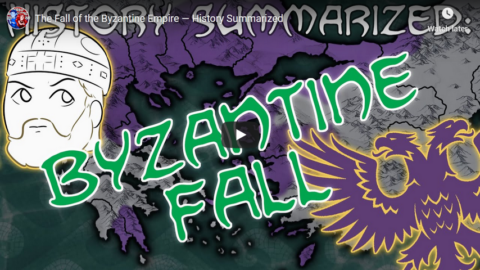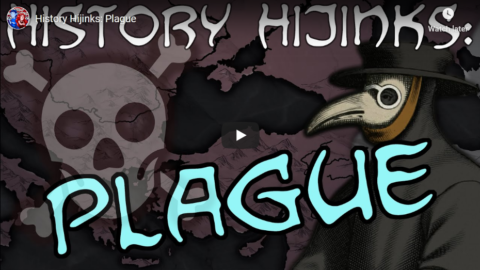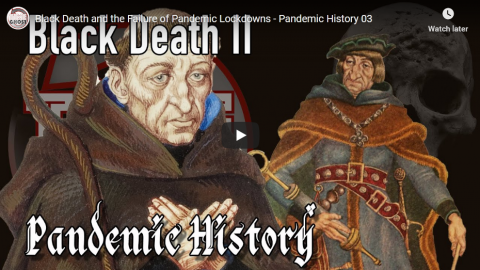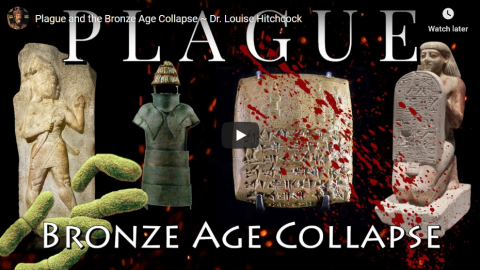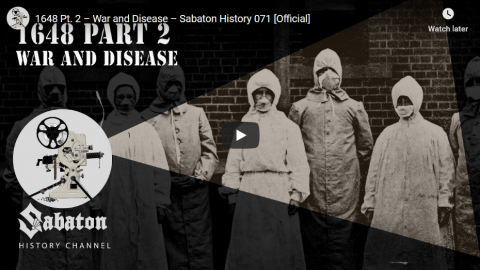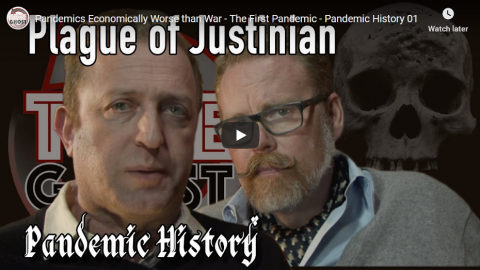Overly Sarcastic Productions
Published 4 Dec 2020At long last, the concluding chapter of Roman history! Let’s tie the bow on Byzantine Constantinople as the empire comes to an end, slightly earlier than we might think, but far later than anybody ever could have expected.
SOURCES & Further Reading: Byzantium: The Decline and Fall & A Short History of Byzantium by John Julius Norwich, Osman’s Dream by Finkel, https://www.ancient.eu/Despotate_of_t…
This video was edited by Sophia Ricciardi AKA “Indigo”. https://www.sophiakricci.com/
Our content is intended for teenage audiences and up.
PATREON: https://www.Patreon.com/OSP
PODCAST: https://overlysarcasticpodcast.transi…
DISCORD: https://discord.gg/osp
MERCH LINKS: http://rdbl.co/osp
OUR WEBSITE: https://www.OverlySarcasticProductions.com
Find us on Twitter https://www.Twitter.com/OSPYouTube
Find us on Reddit https://www.Reddit.com/r/OSP/
December 5, 2020
The Fall of the Byzantine Empire — History Summarized
November 27, 2020
Japanese Plague Bombs – War Against Humanity 023 – November 1941, Pt. 2
World War Two
Published 26 Nov 2020Japanse deploys biological weapons in China, leading to un unspecified number of deaths. Meanwhile, European Jews from Germany and their occupied territories are deported to Eastern Europe, where Jews are already being killed by the thousands.
Join us on Patreon: https://www.patreon.com/TimeGhostHistory
Or join The TimeGhost Army directly at: https://timeghost.tvFollow WW2 day by day on Instagram @ww2_day_by_day – https://www.instagram.com/ww2_day_by_day
Between 2 Wars: https://www.youtube.com/playlist?list…
Source list: http://bit.ly/WW2sourcesHosted by: Spartacus Olsson
Written by: Joram Appel and Spartacus Olsson
Director: Astrid Deinhard
Producers: Astrid Deinhard and Spartacus Olsson
Executive Producers: Astrid Deinhard, Indy Neidell, Spartacus Olsson, Bodo Rittenauer
Creative Producer: Maria Kyhle
Post-Production Director: Wieke Kapteijns
Research by: Joram Appel and Spartacus Olsson
Edited by: Miki Cackowski
Sound design: Marek Kamiński
Map animations: Eastory (https://www.youtube.com/c/eastory)Colorizations by:
Mikołaj Uchman
Spartacus Olsson
Jaris Almazani (Artistic Man), https://instagram.com/artistic.man?ig…Sources:
Bundesarchiv
Visuotinė-lietuvių-enciklopedija
Yad Vashem 2725/5, 4613/360, 85DO1, 142BO7, 4613/1055, 4147/32, 8747/3, 4360/99, 4613/525, 4572/3, 4572/2, 4572/4
USHMM
Picture of Jezdimir Dangic, courtesy of pogledi.rs
from the Noun Project: Skull by Muhamad UlumSoundtracks from the Epidemic Sound:
Farrell Wooten – “Blunt Object”
Yi Nantiro – “A Single Grain Of Rice”
Philip Ayers – “Trapped in a Maze”
Gavin Luke – “Drifting Emotions 3”
Gunnar Johnsen – “Not Safe Yet”
Cobby Costa – “From the Past”Archive by Screenocean/Reuters https://www.screenocean.com.
A TimeGhost chronological documentary produced by OnLion Entertainment GmbH.
From the comments:
World War Two
3 hours ago
We often get the question how we cope with researching, editing and hosting a series which is almost exclusively about human suffering. Indeed, for every episode that we make, Miki, Spartacus and I spend hours researching, reading accounts and scrolling through gruesome pictures. It is hard or stressful at times, and of course it impacts us emotionally.There’s a couple of things that help us get through this. The purpose with which we’re doing this, which is to learn, share and contribute to awareness so that this may never be forgotten definitely adds to our resilience. We have set up a small-scale support system between us, and we try to talk and share our emotions whenever we need to.
We recognise that some of you watching this may deal with similar questions. Talking about it, wether digitally or in person, helps us understand and process. We believe that exploring the motivations and fears of perpetrators and victims also helps to stay in touch with the human dimension behind staggering statistics. We try our best to keep this series down to earth with a close eye on the humane aspect – both in content and our community.
Thank you all for your support and kind comments,
Cheers,
Joram
October 22, 2020
When England “Londonized”
In the latest Age of Invention newsletter, Anton Howes looks at changes in urbanization in England from the Middle Ages onward and the astonishing growth of London in particular:
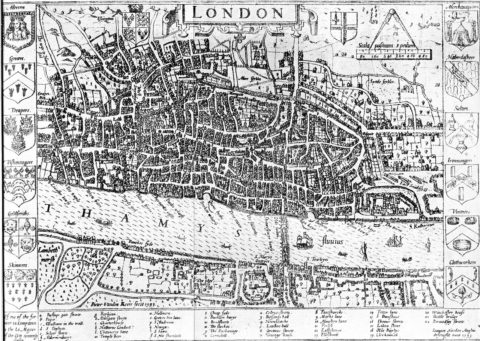
John Norden’s map of London in 1593. There is only one bridge across the Thames, but parts of Southwark on the south bank of the river have been developed.
Wikimedia Commons.
We must thus imagine pre-modern England as a land of tens of thousands of teeny tiny villages, each having no more than a couple of hundred people, which were in turn served by hundreds of slightly larger market towns of no more than a few hundred inhabitants, and with only a handful of regional centres of more than a few thousand people. By the 1550s, the country’s population had still not recovered to its pre-Black Death peak, and still only about 4% of the population lived in cities. London alone accounted for about half of that, with approximately 50-70,000 people (about five times the size of its closest rival, Norwich). So after a couple of centuries of recovery, London was only a little past its medieval peak.
But over the following century and a half, things began to change. At first glance, England’s continued population growth was unremarkable. By 1700, its overall population had finally reached and even surpassed the medieval 5 million barrier, despite the ravages of civil war. This was, perhaps, to be expected, with a little additional agricultural productivity allowing it to surpass the previous record. But the composition of that population had changed radically, largely thanks to the extraordinary growth of London. England’s overall population had not only recovered, but now 16% of them lived in cities of over 5,000 inhabitants — over two thirds of whom lived in London alone. Rather than simply urbanise, England londonised. By 1700, the city was nineteen times the size of second-place Norwich — even though Norwich’s population had more or less tripled.
London had, by 1700, thus risen from obscurity to become one of the largest cities in Europe. At an estimated 575,000 people, it was rivalled in Europe only by Paris and Constantinople, both of which had been massive for centuries. And although by modern standards it was still rather small, it could at least now be comfortably called a city — more or less on par with the populations of modern-day Glasgow or Baltimore or Milwaukee.
During that crucial century and a half then, London almost single-handedly began to urbanise the country. Its eighteenth-century growth was to consolidate its international position, such that by 1800 the city was approaching a million inhabitants, and from the 1820s through to the 1910s was the largest city in the world. In the mid-nineteenth century England also finally overtook Holland in terms of urbanisation rates, as various other cities also came into their own. But this was all just the continuation of the trend. London’s growth from 1550 to 1700 is the phenomenon that I think needs explaining — an achievement made all the more impressive considering how many of its inhabitants were dropping dead.
Throughout that period, urban death rates were so high that it required waves upon waves of newcomers from the countryside to simply keep the population level, let alone increase it. London was ridden with disease, crime, and filth. Not to mention the occasional mass death event. The city lost over 30,000 souls — almost of a fifth of its population — in the plague of 1603 (which was apparently exacerbated by many thousands of people failing to social distance for the coronation of James I), followed by the loss of a fifth again — 41,000 deaths — in the plague of 1625, and another 100,000 deaths — by now almost a quarter of the city’s population — in 1665. And yet, between 1550 and 1700 its population still managed to increase roughly tenfold.
I’ve been hard-pressed to find an earlier, similarly rapid rise to the half-a-million mark that was not just a recovery to a pre-disaster population or simply the result of an empire’s seat of government being moved. Chang’an, Constantinople, Ctesiphon, Agra, Edo, for example — all owed their initial, massive populations to an administrative change (often accompanied by a degree of forcible relocation), and all then grew fairly gradually up to or beyond half a million. As for a very long-term capital like Rome, it seems to have taken about three or four centuries to achieve the increases that London managed in just one and a half (though bear in mind just how rough and ready our estimates of ancient city populations are — our growth guesstimate for Rome is almost entirely based on the fact that the water supply system roughly doubled every century before its supposed peak). The rapidity of London’s rise from obscurity may thus have been unprecedented in human history — and was certainly up there with the fastest growers — though we’ll likely never know for sure.
But how? I can think of a multitude of factors that may have helped it along, but I find that each of them — even when considered altogether — aren’t quite satisfactory.
July 20, 2020
History Hijinks: Plague
Overly Sarcastic Productions
Published 17 Jul 2020Escape the worries of our modern world by visiting the high middle ages and learning about something esoteric and irrelevant: Plague!
In this video, I attempt to actually teach you something about how the medieval world worked and how it responded to this existential threat, rather than dredging up 3rd grade plague facts for easy views. Oops, did I say that out loud?
SOURCES & Further Reading: The Black Death: The World’s Most Devastating Plague via The Great Courses by Dorsey Armstrong, “From Plague Doctor to PPE” by Bernadette Banner (https://youtu.be/ZniriC-jTHg), “Biological Warfare at the Siege of Caffa” from the CDC (https://wwwnc.cdc.gov/eid/article/8/9…)
This video was edited by Sophia Ricciardi AKA “Indigo”. https://www.sophiakricci.com/
Our content is intended for teenage audiences and up.
DISCORD: https://discord.gg/kguuvvq
PATREON: https://www.Patreon.com/OSP
MERCH LINKS: https://www.redbubble.com/people/OSPY…
OUR WEBSITE: https://www.OverlySarcasticProductions.com
Find us on Twitter https://www.Twitter.com/OSPYouTube
Find us on Reddit https://www.Reddit.com/r/OSP/
July 7, 2020
QotD: The first invasion of Britain
Before about 2500 BC, ancient Albion was inhabited largely by farmers tracing back to the Fertile Crescent. Suddenly, steppe barbarians, bearing the Bell Beaker culture, arrived, and almost immediately most of the old Britons died off.
Since then, 90 percent of subsequent skeletons in England reflect the DNA of the steppe invaders.
What happened to most of England’s earlier inhabitants? One of the less violent scenarios is that the steppe migrants introduced bubonic plague.
In general, “migration” and “mixture” tend in Reich’s book to serve as euphemisms for genocide of the native males and rape of the native females. Reich lists numerous examples from around the world where genetic data show that newcomers enslaved or murdered the local men and turned their women into concubines.
Fortunately, for the past 4,500 years, “ancient Britons harbored a blend of ancestries very similar to that of present-day Britons.” The Roman conquest didn’t leave much of a genetic mark, and the later Anglo-Saxon, Danish, and Norman invaders were genetically similar enough to earlier Britons that geneticists have only recently begun to disentangle them.
After 1066, the island race enjoyed a long halcyon era without new invaders raping and pillaging. But all good things evidently have to come to an end. As Benjamin Schwarz has pointed out, “In fact, Britain today receives more immigrants in a single year than it did in the entire period from 1066 to 1950.”
Steve Sailer, “Reich’s Laboratory”, Taki’s Magazine, 2018-03-28.
June 18, 2020
Black Death and the Failure of Pandemic Lockdowns – Pandemic History 03
TimeGhost History
Published 17 Jun 2020Starting in 1347 and for three centuries, the second plague pandemic provides ample time to learn how to deal with the recurring outbreaks. And yet, fears of ruining the economy, political expediency, and refusal to accept reality leaves those trying to implement protection measure to fight an uphill battle. The result is even worse economic consequences, and unfathomable death.
Join us on Patreon: https://www.patreon.com/TimeGhostHistory
Hosted by: Indy Neidell and Spartacus Olsson
Written by: Indy Neidell and Spartacus Olsson
Directed by: Astrid Deinhard
Executive Producers: Astrid Deinhard, Indy Neidell, Spartacus Olsson, Bodo Rittenauer
Creative Producer: Joram Appel
Post-Production Director: Wieke Kapteijns
Research by: Spartacus Olsson, Indy Neidell, and James Currie
Edited by: Karolina Dołęga
Sound Engineer: Marek Kamiński
Graphic Design: Ryan WeatherbyVisual Sources:
Wellcome Images
Patrick Gray on Flickr: https://www.flickr.com/photos/1360415…
Paul K on Flickr: https://www.flickr.com/photos/bibliod…
Quinto Tiberio Angelerio and New Measures for Controlling Plague in 16th-Century Alghero, Sardinia digitalized by Google, original from Universidad Complutense de MadridIcons from The Noun Project by: Ben Mullins, parkjisun, Muhamad Ulum & Adrien Coquet
Music:
“A Far Cry” – Flouw
“Fire Building Ext 3” – SFX Producer
“Last Point of Safe Return” – Fabien Tell
“London” – Howard Harper-Barnes.mp3
“Please Hear Me Out” – Philip Ayers
“Scream Female 3” – SFX Producer
“Scream Male 6” – SFX Producer
“Superior” – Silver Maple
“Symphony of the Cold-Blooded” – Christian Andersen
“Barrel” – Christian AndersenArchive by Screenocean/Reuters https://www.screenocean.com.
Research Sources:
Quinto Tiberio Angelerio and New Measures for Controlling Plague in 16th-Century Alghero, Sardinia Raffaella Bianucci, Ole Jørgen Benedictow, Gino Fornaciari, and Valentina Giuffra
“The Path to Pistoia: Urban Hygiene Before the Black Death”, G. Geltner, Past & Present, Volume 246, Issue 1, February 2020, Pages 3–33
Encyclopedia of the Black Death, Joseph Patrick Byrne
“Epidemiological characteristics of an urban plague epidemic in Madagascar, August–November, 2017: an outbreak report”, The Lancet, Rindra Randremanana, PhD, *Voahangy Andrianaivoarimanana, PhD, Birgit Nikolay, PhD, Beza Ramasindrazana, PhD, Juliette Paireau, PhD, Quirine Astrid ten Bosch, PhD, et al
Yersinia pestis, the cause of plague, is a recently emerged clone of Yersinia pseudotuberculosis, Mark Achtman, Kerstin Zurth, Giovanna Morelli, Gabriela Torrea, Annie Guiyoule, and Elisabeth Carniel
Insights into the evolution of Yersinia pestis through whole-genome comparison with Yersinia pseudotuberculosis, P.S.G. Chain, E. Carniel, F.W. Larimer, J. Lamerdin, P.O. Stoutland, W.M. Regala, A.M. Georgescu, L.M. Vergez, M.L. Land, V.L. Motin, R.R. Brubaker, J. Fowler, J. Hinnebusch, M. Marceau, C. Medigue, M. Simonet, V. Chenal-Francisque, B. Souza, D. Dacheux, J.M. Elliott, A. Derbise, L.J. Hauser, and E. Garcia
Distinct Clones of Yersinia pestis Caused the Black Death, Stephanie Haensch, Raffaella Bianucci, Michel Signoli, Minoarisoa Rajerison, Michael Schultz, Sacha Kacki, Marco Vermunt, Darlene A. Weston, Derek Hurst, Mark Achtman, Elisabeth Carniel, and Barbara BramantiA TimeGhost chronological documentary produced by OnLion Entertainment GmbH.
From the comments:
TimeGhost History
2 days ago
As you have seen in this episode collective learning takes time. Some of you might infer one to one parallels between the situation during the second plague pandemic and our current pandemic in 2020. That would not be entirely correct and definitely not our intention. History doesn’t as much repeat itself as it echos into the present. While there are similarities between all pandemics, and we continue to struggle to find the correct response and countermeasures, our times are very different from the medieval and renaissance world. Science has developed further, society has evolved, and we have much more than one form of response to disease available. Moreover the pandemic that started in 1347 is in relative numbers (percentage of lethality) the worst pandemic to hit humanity in known history.In the end we are historians, not health professionals or epidemiologists. Our contribution can never be what to do about COVID 19, that is too complex an issue for us to digest. What we can contribute is a historical perspective on what went wrong back then, and how we developed from there. The main takeaway from the Black Death should from that long term historical perspective be positive. The response lay the foundation of modern health care in hospitals. It helped create the beginnings of professional, trained, and vetted doctors, it changed the view on sanitation, and it started to shift our collective view on disease from superstition and conspiracy myths to factual analysis and a scientific response.
And there in that very last point lies perhaps the one and only thing that we can say with certainty that we need to remember in 2020 — listen to the scientists, not the hacks and politicians on all sides that base their rhetoric on, self interest, political expediency, and populism.
Never forget!
Spartacus
PS apologies for the audio problems on my mic during the first half of the video — it was scratching against my jacket and no one noticed, sadly we can’t get it out in post.
June 16, 2020
Plague and the Bronze Age Collapse ~ Dr. Louise Hitchcock
The Study of Antiquity and the Middle Ages
Published 16 May 2020Ladies and Gentlemen, welcome to the series NAUE II SWORDS, GERMS, & IRON brought to us by none other than Dr. Louise Hitchcock and this episode is going to be about plague and the Bronze Age collapse. This episode will also be drawing on modern parallels such as “What Covid-19 Can Tell Us About the Bronze Age (12th cent) Collapse?”
It will dive into the Bronze Age and discuss was plague a contributing factor in decline of the Bronze Age and the birth of the Iron Age? How familiar were the ancient peoples with plague and epidemics and what do the ancient literary sources tell us? From discussing plague in ancient Mesopotamia to the Philistine Plague to a Hittite King who falls prey to a deadly disease we explore new thoughts, theories and research involving a period that we all love and a subject that could not be more relevant and that is plague.
Check out the awesome work of Dr. Hitchcock at these links below!
Academia profile where you can access her work that is free to the public. https://unimelb.academia.edu/LouiseHi…
Get her books here!
Aegean Art and Architecture: https://global.oup.com/ukhe/product/a…
Minoan Architecture: A Contextual Analysis: http://www.astromeditions.com/books/b…
Theory for Classics: https://www.routledge.com/Theory-for-…
DAIS: The Aegean Feast https://www.peeters-leuven.be/detail….
Tell It In Gath: Studies in the History and Archaeology of Israel. Essays in Honor of Aren M. Maeir on the Occasion of his Sixtieth Birthday https://www.zaphon.de/epages/83179382…Follow her on Twitter: https://twitter.com/ashlarblocks
To support the channel, become a patron and make history matter!
Patreon: https://www.patreon.com/the_study_of_…
Donate directly to paypal: https://paypal.me/nickbarksdale
Enjoy history merchandise? Check out our affiliate link to spqr emporium! http://spqr-emporium.com?aff=3
*disclaimer, the link above is an affiliate link which means we will earn a generous commission from your magnificent purchase, just another way to help out the channel! join our community!twitter: https://twitter.com/nickbarksdale
instagram: https://www.instagram.com/study_of_an…Image credits: Manna Nader, Gabana Studios Cairo
Hittite 3D City and intro footage credits: 3D reconstruction of Imperial Hittite Karkemish by Giampaolo Luglio, Turco-Italian Archaeological Expedition to Karkemish directed by Nicolò Marchetti (University of Boologna)
KARKEMISH (Carchemish) 1300 BC (3D) – The Southern Capital of the Empire Hittite https://youtu.be/RsTdoY__F4U
Music Attribution: Herknungr – Megaliths | Dark Neolithic Meditive Shamanic Ambient Music https://youtu.be/oc8FQwNjPu0
Footage of Ugarit Credit goes to Ruptly. Video Title : Syria: Ancient city of Ugarit freed from Islamic State control https://youtu.be/XKzbk0PFvg0
June 13, 2020
“1648” Pt. 2 – War and Disease – Sabaton History 071 [Official]
Sabaton History
Published 12 Jun 2020War and Plague. Just two horsemen of the apocalypse but never really far away from each other. Where armies march, disease usually follows. From the earliest records of time to modern day, epidemics and contagious diseases are the cause of uncountable deaths. Pandemics like the Spanish Flu or the Bubonic Plague killed millions of people around the world. To survive, mankind had resort to quarantines and plague houses, and put its trust to physicians and the evolution of modern medicine.
Support Sabaton History on Patreon: https://www.patreon.com/sabatonhistory
Listen to “1648” on the album Carolus Rex:
CD: http://bit.ly/CarolusRexStore
Spotify: http://bit.ly/CarolusRexSpotify
Apple Music: http://bit.ly/CarolusRexAppleMusic
iTunes: http://bit.ly/CarolusRexiTunes
Amazon: http://bit.ly/CarolusRexAmz
Google Play: http://bit.ly/CarolusRexGooglePlayListen to Sabaton on Spotify: http://smarturl.it/SabatonSpotify
Official Sabaton Merchandise Shop: http://bit.ly/SabatonOfficialShopHosted by: Indy Neidell
Written by: Markus Linke and Indy Neidell
Directed by: Astrid Deinhard and Wieke Kapteijns
Produced by: Pär Sundström, Astrid Deinhard and Spartacus Olsson
Creative Producer: Joram Appel
Community Manager: Maria Kyhle
Executive Producers: Pär Sundström, Joakim Broden, Tomas Sunmo, Indy Neidell, Astrid Deinhard, and Spartacus Olsson
Post-Production Director: Wieke Kapteijns
Edited by: Karolina Dołęga
Sound Editing by: Marek Kaminski
Maps by: Ryan Weatherby, Karolina DołęgaEastory YouTube Channel: https://www.youtube.com/channel/UCEly…
Archive by: Reuters/Screenocean https://www.screenocean.com
Music by Sabaton.Sources:
– Welcome Images
– National Library of Scotland
– IMW: Q 10378,
– National Museum of Health and Medicine
– National Archives
– Icons from The Noun Project by: Muhamad Ulum & Adrien CoquetAn OnLion Entertainment GmbH and Raging Beaver Publishing AB co-Production.
© Raging Beaver Publishing AB, 2019 – all rights reserved.
June 11, 2020
Black Death Mystery Solved – Not Bubonic Plague – Pandemic History 02
TimeGhost History
Published 10 Jun 2020From the day the Black Death starts to ravage humanity in 1347, there will be speculation about what it is. It will take until 2017 for science to give us a conclusive answer to the riddle how so many people could die so fast all over Europe, Africa, and Asia in only five years.
Join us on Patreon: https://www.patreon.com/TimeGhostHistory
Hosted by: Indy Neidell and Spartacus Olsson
Written by: Indy Neidell and Spartacus Olsson
Directed by: Astrid Deinhard
Executive Producers: Astrid Deinhard, Indy Neidell, Spartacus Olsson, Bodo Rittenauer
Creative Producer: Joram Appel
Post-Production Director: Wieke Kapteijns
Research by: Spartacus Olsson, Indy Neidell, and James Currie
Edited by: Karolina Dołęga
Sound Engineer: Marek Kamiński
Graphic Design: Ryan WeatherbyVisual Sources:
Welcome Images
Mark and Delwen from Flickr: https://www.flickr.com/photos/markand…
Smarteeee from Wiki CommonsIcons from The Noun Project by: arif fajar yulianto, James, Maxim Kulikov, Jejen Juliansyah Nur Agung, Gan Khoon Lay, Alfonso Melolonta Urbán
Laymik, parkjisun, Eucalyp, Adrien Coquet & Mahmure Alp.Music:
“Barrel” – Christian Andersen
“Symphony of the Cold-Blooded” – Christian Andersen
“Potential Redemption” – Max Anson
“Moving to Disturbia” – Experia
“Superior” – Silver Maple
“Please Hear Me Out” – Philip Ayers
“Guilty Shadows 4” – Andreas Jamsheree
“Deadline” – Marten Moses
“Endlessness” – Flouw
“Moving to Disturbia” – ExperiaArchive by Screenocean/Reuters https://www.screenocean.com.
Research Sources:
Quinto Tiberio Angelerio and New Measures for Controlling Plague in 16th-Century Alghero, Sardinia, Raffaella Bianucci, Ole Jørgen Benedictow, Gino Fornaciari, and Valentina Giuffra
“The Path to Pistoia: Urban Hygiene Before the Black Death”, G. Geltner, Past & Present, Volume 246, Issue 1, February 2020, Pages 3–33
Encyclopedia of the Black Death, Joseph Patrick Byrne
“Epidemiological characteristics of an urban plague epidemic in Madagascar, August–November, 2017: an outbreak report”, The Lancet, Rindra Randremanana, PhD *Voahangy Andrianaivoarimanana, PhD Birgit Nikolay, PhD Beza Ramasindrazana, PhD Juliette Paireau, PhD, Quirine Astrid ten Bosch, PhD et al
“Yersinia pestis, the cause of plague, is a recently emerged clone of Yersinia pseudotuberculosis” Mark Achtman, Kerstin Zurth, Giovanna Morelli, Gabriela Torrea, Annie Guiyoule, and Elisabeth Carniel
“Insights into the evolution of Yersinia pestis through whole-genome comparison with Yersinia pseudotuberculosis“, P.S.G. Chain, E. Carniel, F.W. Larimer, J. Lamerdin, P.O. Stoutland, W.M. Regala, A.M. Georgescu, L.M. Vergez, M.L. Land, V.L. Motin, R.R. Brubaker, J. Fowler, J. Hinnebusch, M. Marceau, C. Medigue, M. Simonet, V. Chenal-Francisque, B. Souza, D. Dacheux, J.M. Elliott, A. Derbise, L.J. Hauser, and E. Garcia
“Distinct Clones of Yersinia pestis Caused the Black Death”, Stephanie Haensch, Raffaella Bianucci, Michel Signoli, Minoarisoa Rajerison, Michael Schultz, Sacha Kacki, Marco Vermunt, Darlene A. Weston, Derek Hurst, Mark Achtman, Elisabeth Carniel, Barbara BramantiA TimeGhost chronological documentary produced by OnLion Entertainment GmbH.
From the comments:
TimeGhost History
2 days ago
There is much we can learn from history and as you will see in the next two episodes of our impromptu pandemics series it takes a long time for us to make these learnings. Many of the mistakes made during the outbreak of the Black Death are still an issue as we respond to COVID-19 almost 700 years later. This episode was also a very personal learning experience for us, Indy and Spartacus. Both of us read and studied a lot about the plague when we were younger in the 1980s, Indy even did his BA paper in history on the plague. Back then there was a lot of speculation about what the Black Death actually was (although the general consensus was that it must have been bubonic plague based on the findings made in the 20th century, after the discovery of the Yersinia Pestis bacteria). But that conclusion was a bit problematic — the Black Death was too lethal, spread too fast, and killed people too quickly for bubonic plague. Until we started researching these episodes we hadn’t spent much thought on the topic, so imagine our surprise when we discovered that bacteriologists, epidemiologists, and archeologists had come together to solve the mystery after two chance occurrences of unusual plague outbreaks in 2014 and 2017. To paraphrase Lord Marlborough: if you want to truly learn something about a topic, there’s no better way than to make a video about it.
June 4, 2020
Performance, Plague, and Politics in Shakespeare’s London
Atun-Shei Films
Published 27 Mar 2020Help us make the first feature film ever made (that we know of) spoken entirely in Original Pronunciation, the accent of Shakespeare: https://igg.me/at/sudburydevil/x/1502…
Did William Shakespeare write King Lear under quarantine? That is the question. In this video I introduce you to the actor’s process in Elizabethan theater; dive deep into first-hand accounts of the bubonic plague epidemics that Shakespeare lived through; explore the politics of late 16th and early 17th century England, onstage and off; and discuss OP, Original Early Modern English Pronunciation, the accent and dialect in which the Bard’s plays were originally performed.
The rest is silence.
Support Atun-Shei Films on Patreon ► https://www.patreon.com/atunsheifilms
#English #Theater #History
Watch our film ALIEN, BABY! free with Prime ► http://a.co/d/3QjqOWv
Reddit ► https://www.reddit.com/r/atunsheifilms
Twitter ► https://twitter.com/atun_shei
Instagram ► https://www.instagram.com/atunsheifilms
Merch ► https://atun-sheifilms.bandcamp.com
From the comments:
Atun-Shei Films
1 month ago
CORRECTION: The Great Vowel Shift was a SEPARATE linguistic trend to the R-dropping in 18th century English. My mistake, sorry!
April 11, 2020
Pandemics Economically Worse than War – The First Pandemic – Pandemic History 01
TimeGhost History
Published 10 Apr 2020There is much we can learn from past pandemics, like how Emperor Justinian ruined the Eastern Roman Empire’s economy and made the first plague pandemic even worse.
Join us on Patreon: https://www.patreon.com/TimeGhostHistory
Hosted by: Indy Neidell and Spartacus Olsson
Written by: Spartacus Olsson
Directed by: Astrid Deinhard
Executive Producers: Bodo Rittenauer, Astrid Deinhard, Indy Neidell, Spartacus Olsson
Creative Producer: Joram Appel
Post-Production Director: Wieke KapteijnsResearch by: Spartacus Olsson
Edited by: Spartacus OlssonArchive by Reuters/Screenocean http://screenocean.com
A TimeGhost chronological documentary produced by OnLion Entertainment GmbH.
From the comments:
TimeGhost History
3 minutes ago
As announced, here is the first instalment of our impromptu series on the history of pandemics. Now, as you will see in the video this is not just a reaction to the current COVID-19 pandemic, but very much back to the roots for us. Indy studied the pandemics extensively back in university times, and to study history in general requires a somewhat morbid fascination with human disaster in general. So we have spent many, many years looking intently at the worst disasters that have befallen humanity — and there is nothing worse than disease, especially on a pandemic scale. Hopefully this is the time when we can share a bit of that amassed knowledge to add a little timely understanding of the greater effects of pandemics, beyond the immediate tragic medical ones, like how they have impacted society, the economy, and human life in general throughout history. While we cannot give you fixed schedule for this series (we have the regular programming to take care of) we will try to come out with the next one very soon.A note on a statement I make in the video: when I say COVID-19 might be the first time we successfully fight back a pandemic, I am saying that fully aware of the eradication of small pox and the near eradication of polio, the flu vaccine successes and so on — but that is avoidance of recurring pandemics of a specific kind and we have made more progress there than actually handling pandemics of a new disease when they break out for the first time. On that note, take care, stay safe, and may you be healthy despite these trying times.
Spartacus
March 18, 2020
A classic “dirty book” of the late Middle Ages
I’m not well read in the classics, being much more of a history reader myself, so I didn’t know anything about The Decameron. Arthur Chrenkoff provides a helpful thumbnail of the book:
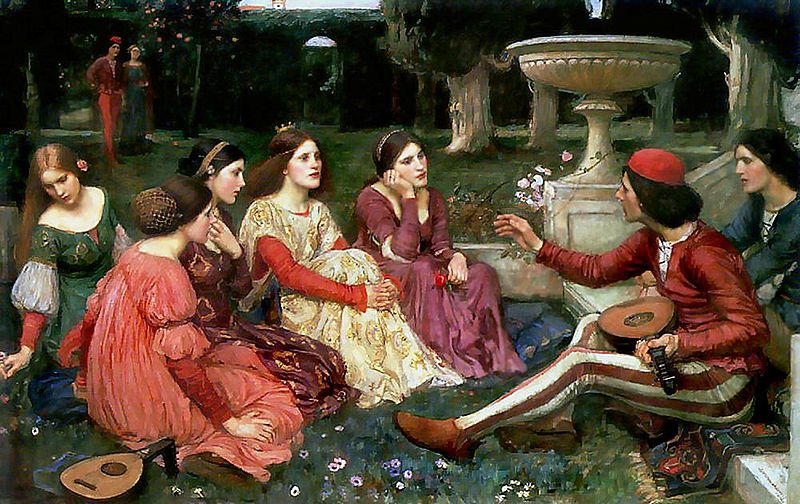
“A Tale from the Decameron” by John William Waterhouse (1916).
Image from the Lady Lever Art Gallery via Wikimedia Commons.
Giovanni Boccaccio had written The Decameron in the aftermath of the Black Death pandemic of 1348, which carried away somewhere around one third of the European population. The book is set in a monastery, where seven young women and three young men, the Millennials of the day, self-quarantine themselves for ten days to avoid the plague and while away their days (there was no internet in those days, you see) telling each other stories, ten each day, all based around a chosen theme, such as love that ends happily or the tricks that women play on men. Many of the stories are a bit dirty, which is why The Decameron was put on the Catholic Church’s index of prohibited books; more interestingly, it was also banned in Australia until 1973, on pretty similar grounds.
March 1, 2020
The Black Death of the 14th Century
Ed West looks at what we know of the spread of the worst plague to hit western Europe in the 1300s:
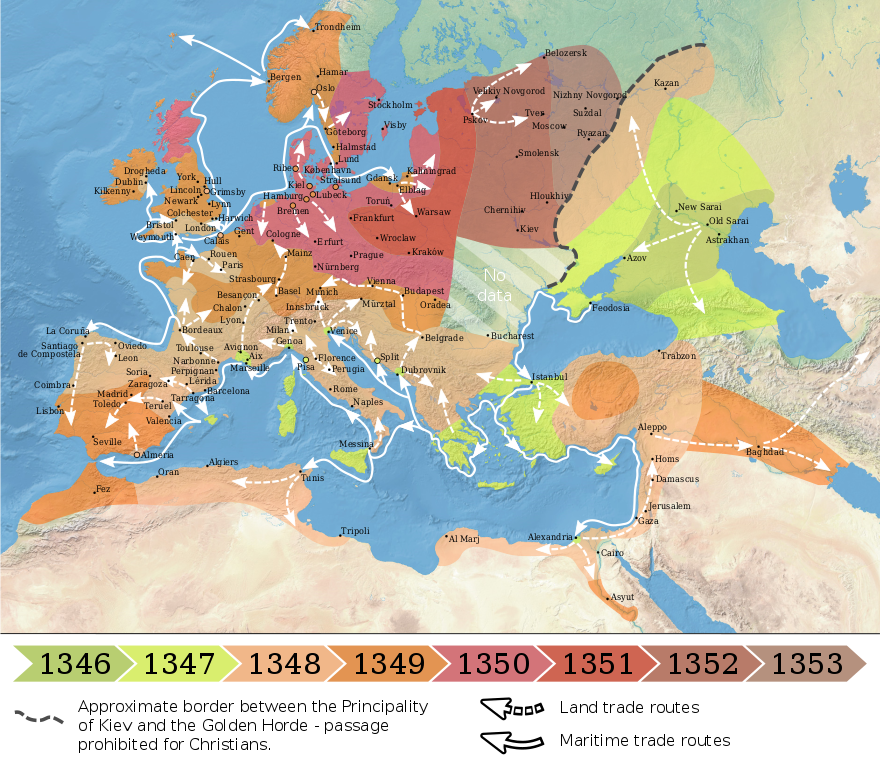
Map showing the spread of the Black Death in Europe between 1346 and 1353.
Map by Flappiefh via Wikimedia Commons.
There had never been a terror like it, and the “Great Mortality” as it was known — and much later, the “Black Death” — has seared itself in the European imagination. It changed the culture and tested the institutions of the time, and as we anxiously await the arrival of another — thankfully far less deadly — contagion from Italy its legacy and impact are worth remembering.
Epidemics have been around as long as civilization. Plaga — from the Greek for “strike” or “hit” — devastated classical Athens in the 5th century BC, when the historian Thucydides nursed sufferers; the Antonine Plague — probably smallpox or measles — killed as many as five million Romans at the empire’s peak. Far more deadly was the Plague of Justinian in the sixth century, which had a toll of 25 million and emptied whole regions of the eastern (Byzantine) Empire. Only in the 21st century did researchers confirm that this was the same illness that would appear eight centuries later — the Bubonic Plague.
Empires were particularly affected by these horrific epidemics, because empires are a form of globalisation — bringing different people into contact with each other and, more dangerously, into contact with other mammals, who act as disease vectors.
Another danger is climate change, which might turn a mild virus into a deadly one, or cause disease-carrying animals to migrate. This is what happened during the 14th century when the northern hemisphere became considerably cooler, soon after the Mongols had created the largest contiguous empire in history.
Genghis Khan’s people have generally received a historical bad press — people are more likely to recall the pyramid of skulls and the Tigris flowing black and red — yet their rule had opened up trade routes, allowing goods and people to cross Asia. Whether brought at the point of a sword or a trade deal, globalisation always brings the new: new cultures, new ideas, new languages and new pathogens.
Yersinia pestis had been living on gerbils and other rodents in central Asia, but unstable climate conditions in 1330s caused the disease to jump onto the rat flea. It was killing people by 1339, and in the mid-1340s Christians first heard of a disease raging in the Islamic world, which some at least took as divine punishment for the crusades.
After two centuries of Holy War this was understandable, yet hatred was not universal and during these conflicts Italian merchants had continually done business with Muslims, much to the Church’s fury. Now this trade, once the source of prosperity and peace, proved deadly: plague reached Europe via the Genovese colony of Caffa on the Black Sea (now Feodosiya, in the Ukraine). In October 1347, four ships escaping the diseased city had turned up in Sicily, condemning Italy to its fate.
December 16, 2019
QotD: The Great Pestilence of 1348
Long I have been curious about the Great Pestilence that trimmed the population of Britain and Europe by a third or more, in the fourteenth century. I make too much of it; the plague was a recurring event for centuries before and after. I notice from the tabloids that it is returning, through Africa this time. I know there will be pestilence to come, when we will all think it terribly important. It rivetted attention, I’m sure, in the autumn of 1348, and through the summer of 1349. And yet within a generation it is hardly mentioned.
England, below the Ribble and Tees, is special, thanks to the Domesday Book of the invading, tax-loving Normans, and their general propensity to good record-keeping. The towns and villages ennumerated in 1086 can be traced to the present day; nineteen in twenty are still there. Having figures to start, and through the parish books later, we can track an economic and demographic history with an accuracy possible in no other country. We can know, for instance, of the population boom through the twelfth and thirteenth centuries, which had slackened well before the “Black Death.” And with that boom, impressive advances in farming, technology, and building, as today. Nothing conduces to technical improvement, as a bit of crowding.
This proportion I cited — the nineteen-in-twenty (or more) — which I have from reading in economic history mostly years ago, fascinates my attention. We know large tracts were depopulated, we find the archaeological evidence easily enough. They were planting rye within the walls of Winchester, and many other towns. Everywhere, they had elbow-room again. Our deep ecologists would have been pleased — those who think life on this planet would be better had a few billion souls not been born. As Christianity, and environmentalism, are mortally opposed, and the fourteenth century was overwhelmingly Christian, I expect complaints of overpopulation were differently expressed at the time. Mostly it would have been moaning from younger brothers about the distribution of inherited land.
Always, there have been younger brothers. Always, there have been survivors. What delighted me was the speed with which all the vacant places were filled. As we’ve seen, too, after ghastly wars, demography abhors a vacuum.
David Warren, “Death the real illusion”, Essays in Idleness, 2017-11-04.
November 29, 2019
England’s early search for new markets
In the latest installment of Anton Howes’ Age of Invention, he looks at the multiple crises that afflicted England in the mid-sixteenth century and some of the reactions to those setbacks:
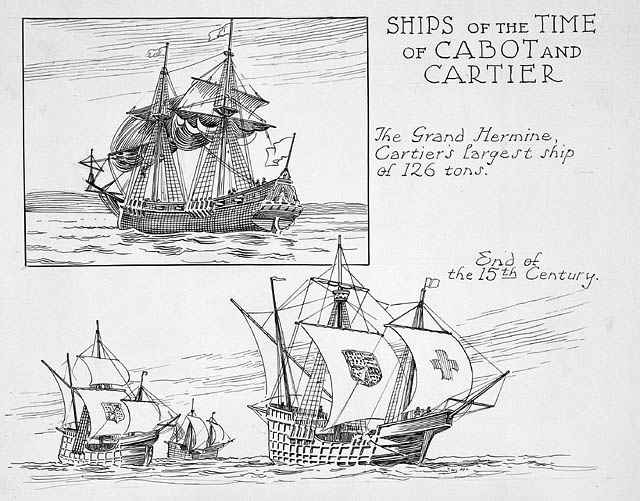
Ships from the period of John Cabot (Giovanni Caboto) and Jacques Cartier.
Illustration by Thomas Wesley McLean (1881-1951) via Wikimedia Commons.
From the 1540s through to the 1560s, [England] was beset by religious uproar, high inflation, hunger, rural and then urban unemployment, a fall-off in its major export trades, and widespread unrest. It was diplomatically isolated too. And I did not even mention the epidemics: the terrifying “sweating sickness” returned in 1551, deadly influenza swept the country in 1557, and in 1563 some 17,000 people in London were reportedly killed by the plague.
Yet, in the face of such problems, innovation in England began to pick up pace. The country, having once been a scientific and technological backwater, began to show signs of catching up. Why?
[…] The fall-off in trade with Europe, for example, seems to have had something to do with spurring the voyages of exploration in search of a north-west and north-east passage to the East Asia. Having lost Antwerp as a place to sell cloth in 1551, the English went in search of an arctic route to northern China and Japan. The expert geographers believed that those regions had a similar climate to that of Antwerp and the surrounding Netherlands, and so reasoned that the Japanese would therefore demand the same kinds of cloth. Although the English expeditions from 1553 onwards did not find a passage to Japan, they did establish trade routes with Russia via the White Sea, and they began to more actively consider the exploration and colonisation of North America. More importantly, with those voyages of exploration came greater experience of navigation, and it was not long before English ships were circumnavigating the globe (Francis Drake in 1577-80). Improvements to navigational techniques and instruments, as well as the ships themselves followed.
So it is tempting to think that necessity was initially the mother of invention, and that the many navigational and shipbuilding improvements of late-sixteenth-century England were its result. But I don’t think that this narrative quite works. I do not believe that necessity was the mother of invention.
For a start, voyages of navigation had already been attempted a number of times, long before the more successful ones in the early 1550s. The first explorers had reputedly gone west from Bristol in 1465, and certainly from 1480. And soon after the announcement of Columbus’s discoveries in the 1490s, the Venetian Zuan Chabotto (aka John Cabot), had sailed from Bristol with Henry VII’s blessing and claimed Newfoundland for both crown and Catholicism. Cabot had even hoped to found a penal colony on his second voyage in 1497, though for some reason the king did not provide the criminals. Throughout the early sixteenth century, the voyages continued. John Rastell, brother-in-law to Thomas More, the famous statesman and author of Utopia, in 1517 went in search of a north-west passage (though he never got beyond Ireland, because his crew decided it would be better to leave him there and sell the ship’s cargo in Bordeaux). Yet another voyage went west with Henry VIII’s support in 1527, but it mostly just found other Europeans — fishing fleets from Spain, Portugal, and France off the coast of Newfoundland (the English had made some catches there in the early 1500s, but apparently could not compete), and the Spanish everywhere else. The expedition made its way down to the Caribbean and then went home, with little to report. So people had already gone off exploring, long before the mid-sixteenth-century English commercial crisis. It suggests that there had already been both a latent supply and demand for such explorations.

